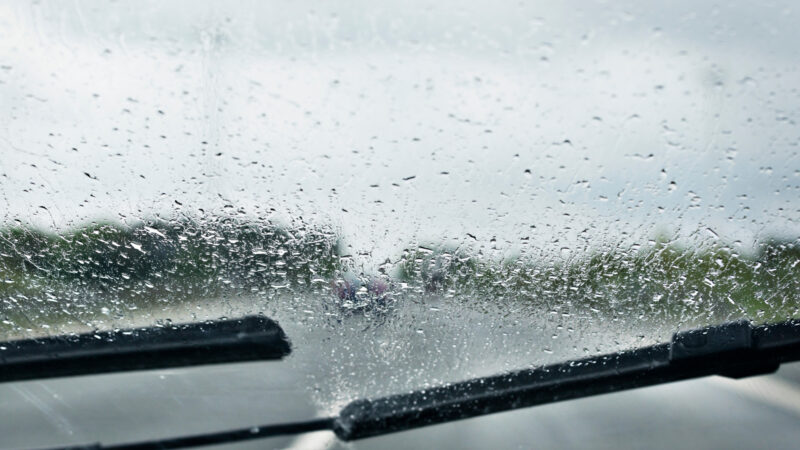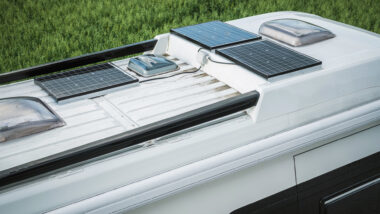Table of Contents Show
Driving in the rain can put your skills and vehicle to the test. You could be in a serious and unsafe situation if you’re not careful.
We want you to have a smooth and safe experience when on the road. Learning to adapt your driving based on the road conditions is a great place to start.
Today, we’re sharing some of our best tips for driving and staying safe while driving in the rain.
So grab your umbrella, and let’s get started!
Is Driving in the Rain Safe?
Driving in the rain can be safe, especially if you take the proper precautions. A wet road can become very slippery, affecting your vehicle’s ability to maintain traction. Typically, the streets are the slickest in the first 10 to 15 minutes after it starts raining. This is because the oils and other liquids trapped in the road come to the surface.
Staying safe in these conditions requires you to make a few adjustments. If not, you could end up in a ditch or a severe accident. We suggest you make the necessary adjustments because neither option is great.
What Are the Dangers of Driving in the Rain?
While it is possible to drive in the rain safely, there are some dangers that you must consider. As we mentioned, roadways are typically the most slippery the first few minutes after it starts to rain. Even if you have new tires with plenty of tread, the slick surface can make it challenging to maintain control.
The wet conditions will also significantly impact your brakes. Even with an advanced braking system, you won’t be able to stop as quickly, which means you could run into the car in front of you or the obstacle in the middle of the road.
You also must remember to consider the reduced visibility. A downpour and water getting kicked up from other vehicles can make seeing obstacles in the road very challenging. It may be too late by the time you finally see it.
Are You Supposed to Drive with Your Hazard Lights on in the Rain?
Many drivers turn their hazard lights on during severe downpours to make themselves more visible. However, in more than half the states, it’s illegal to use them unless it’s an emergency.
Public Safety Information Coordinator Eddy Durkin told Accuweather, “Hazard lights are for vehicles that are stopped and pulled over on the side of the road. It is not for moving vehicles.”
Using your hazard lights can do the exact opposite of what you intend. They can make seeing critical indicators like brake lights and turn signals challenging. This can create a dangerous situation for you and others on the road.
Instead of turning on your hazard lights, find a safe spot to wait out the weather. This allows you to increase your safety and avoid creating a hazardous situation for others. Just make sure your vehicle is entirely off the road. If you can get to a rest stop, gas station, or an exit ramp, these are some of the best places to ride out inclement weather.
Safety Tips for Driving in the Rain
As promised, we have a few tips for driving in the rain. The more you use, the better your chances of staying safe. Let’s see how you can increase your safety while driving in the rain.
Slow Down
One of the first things you should do when driving in the rain is to slow down. This increases the time you have to respond to any hazards in front of you and helps your vehicle maintain traction. You also significantly decrease the chances that you’ll experience hydroplaning and losing control.
How much you slow down will significantly depend on the road. We encountered rainy conditions on the interstate that brought traffic to a complete stop. Reduce your speed to the point that you are comfortable driving.

Keep Your Distance
Along with slowing down, you must keep your distance from other traffic. As we mentioned, rain significantly increases your stopping distance. If you’re not careful, you could plow into the back of the vehicle in front of you.
Normal driving conditions require you to keep two or three seconds between you and other vehicles. However, you’ll want to increase this distance to five or six seconds while it rains. This helps keep you and the other vehicle safe should they need to stop.
Keep in Mind: Can You Leave Your RV Awning Out in the Rain? Let’s find out!
Turn On Headlights
Your headlights should be on if you need to use your windshield wipers. Thankfully, many modern vehicles have automatic lights and wipers. These vehicles can detect when the conditions require headlights. Unfortunately, not every vehicle comes with these fancy features.
If your vehicle doesn’t, it’s a good idea to turn them on every time you get behind the wheel. Having your lights on during the day won’t hurt anything but increases your visibility. You want other vehicles to see you and know where you are on the road.
Defog Windows
The changing temperatures and conditions can do a number on your windows. You may experience them fogging up and being challenging to see. Most vehicles have defrost buttons for the front and rear windows. These features can keep your windows clear and make it easy to see out of them.

Avoid Cruise Control
One of the worst things you can do when driving in the rain is to use cruise control. If your vehicle starts to hydroplane, it may not recognize it immediately, and you can lose control. This can quickly become a scary and dangerous situation.
However, it doesn’t have to be actively raining for this to be a problem. If the road is wet or slick, it’s best not to use cruise control. Depending on the circumstances, maintaining control may require you to let off the accelerator to adapt to the conditions. Do yourself and others a favor by only using this feature if the road conditions are ideal.
Focus on the Road
Any time you’re behind the wheel, your focus must be on the road. However, avoiding distractions while it is raining is vital. Put away your cell phone and avoid messing with the radio or other buttons. No text message or phone call is worth risking your life or the lives of others on the road.
If you can’t control yourself from looking at your phone, put it in a storage compartment or the glove box. If you receive an important call or text message, find a safe place to stop so you can answer it. Trying to multitask while driving is dangerous and often illegal. Give driving the attention it deserves.
Keep in Mind: When the weather is nice, opening your windows is a great choice. However, if the weather isn’t on your side, it might be worth considering investing in an RV vent cover.
Be Patient
Driving in the rain can also test your patience. It’ll likely take longer to get where you’re trying to go. However, it’ll take much longer if you’re not patient and end up in a ditch or accident. A healthy dose of patience can help you avoid making mistakes or experiencing road rage. So try to relax and enjoy the ride.
Stay Safe While Driving in the Rain
If you follow our tips, you stand a much better chance of staying safe while driving in the rain. Unfortunately, accidents happen no matter the weather conditions.
You can’t control how others drive or behave while it is raining. By doing your part, you can help keep yourself and others safe. If you’re ever too uncomfortable driving in the rain, find a safe place to wait.
Do you have any other tips for driving in the rain?






